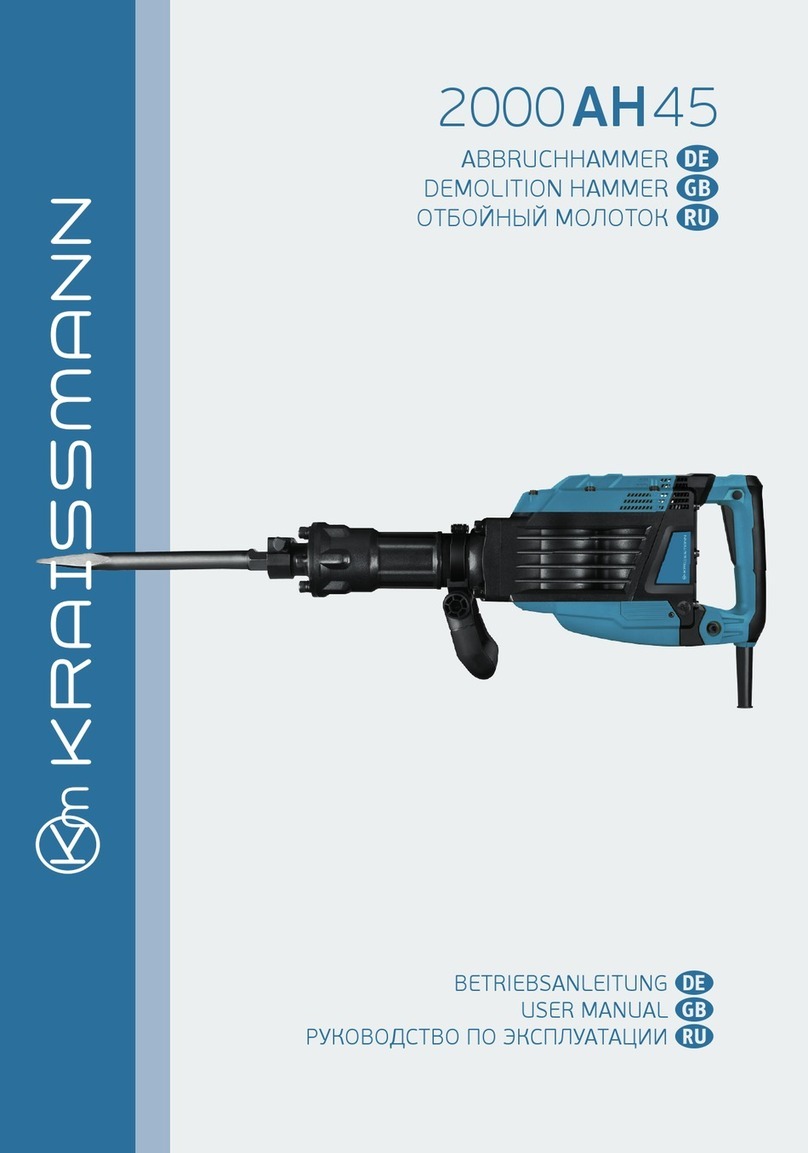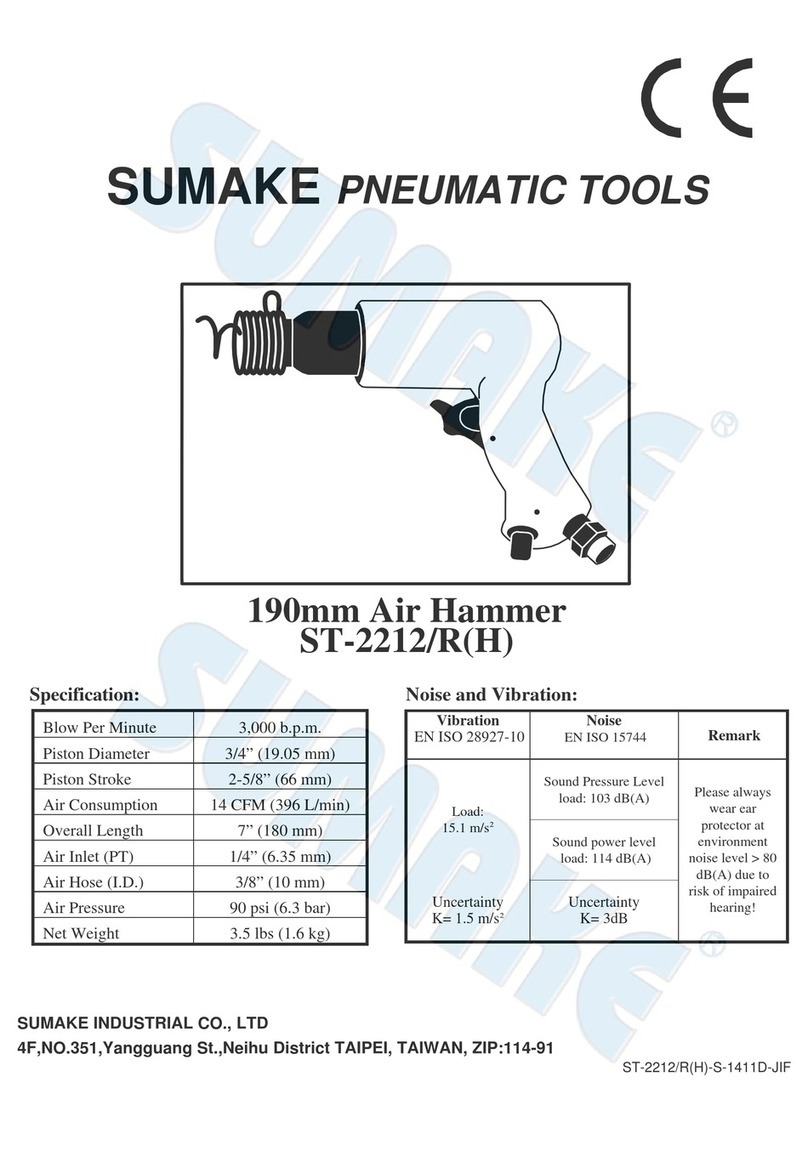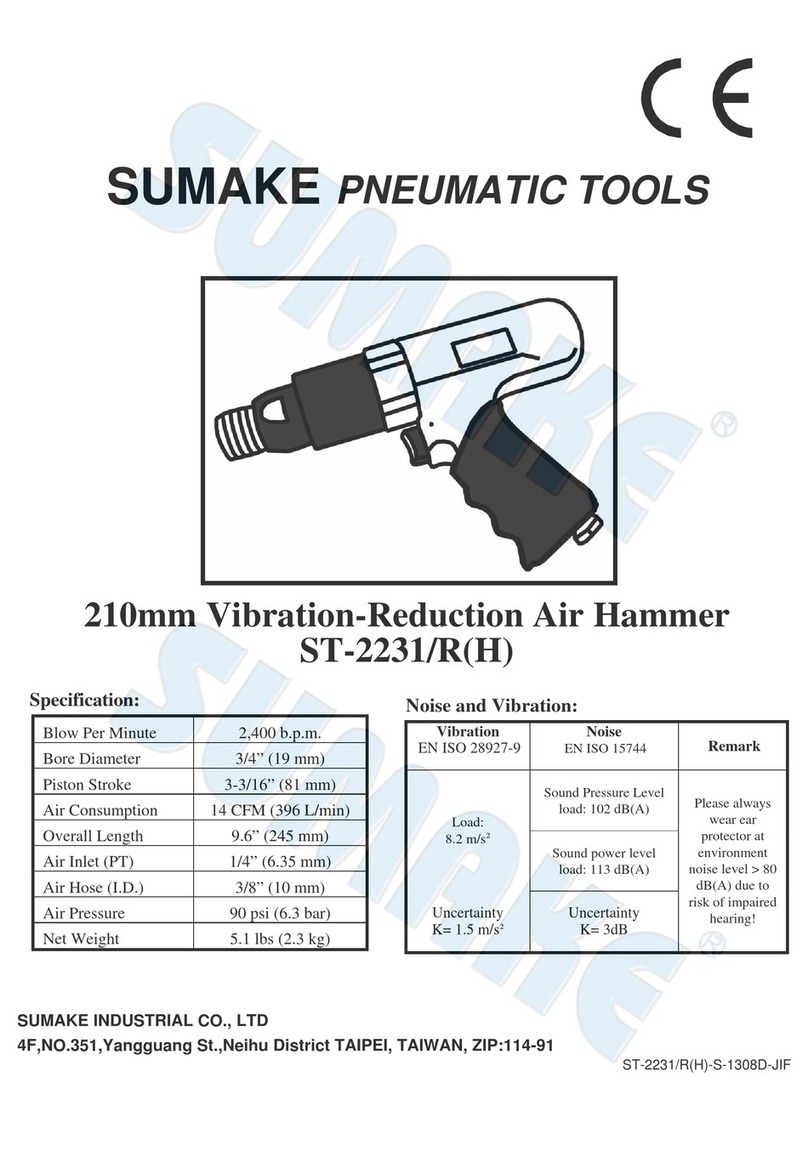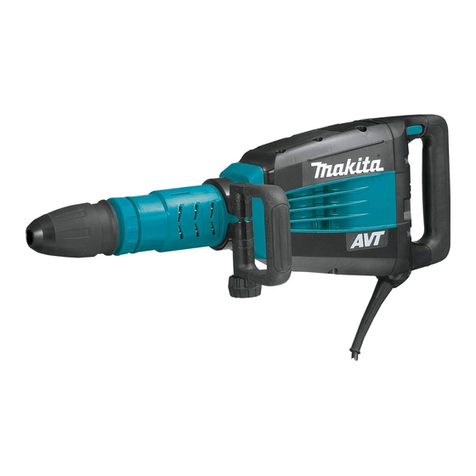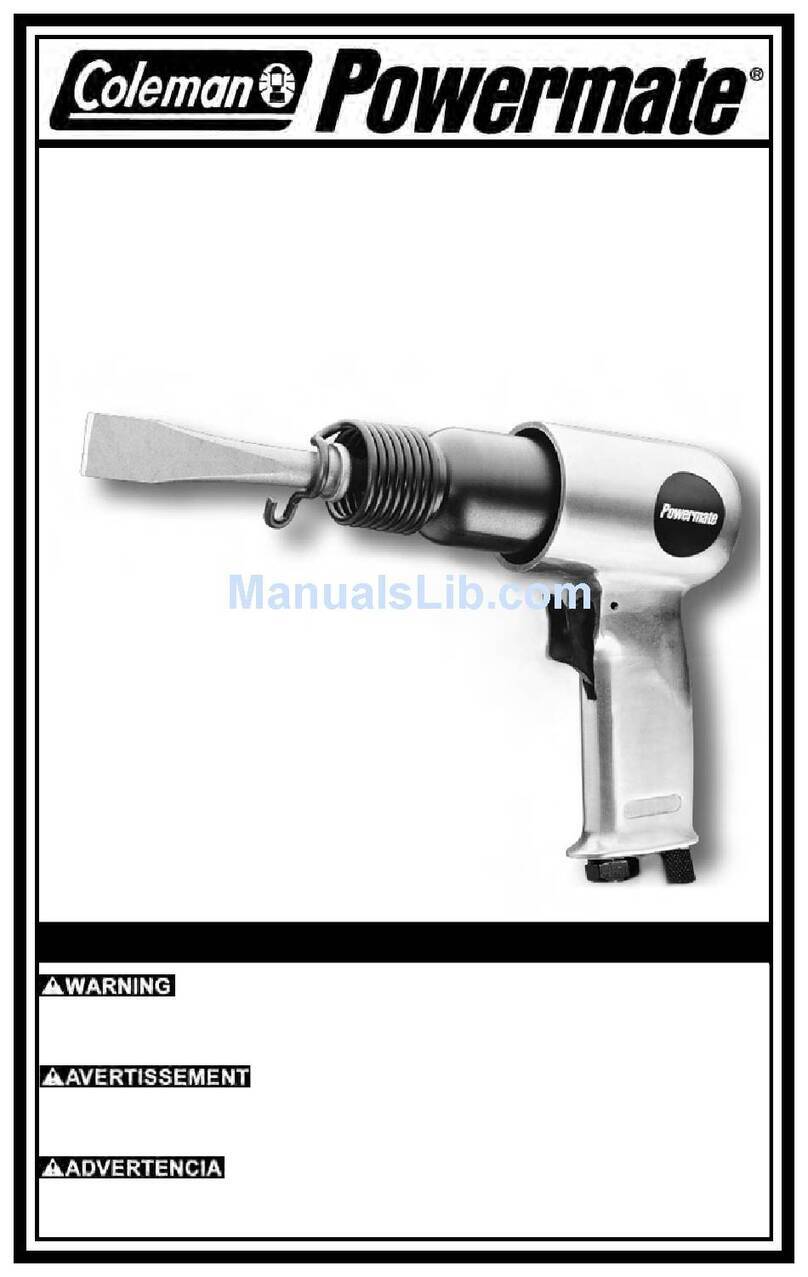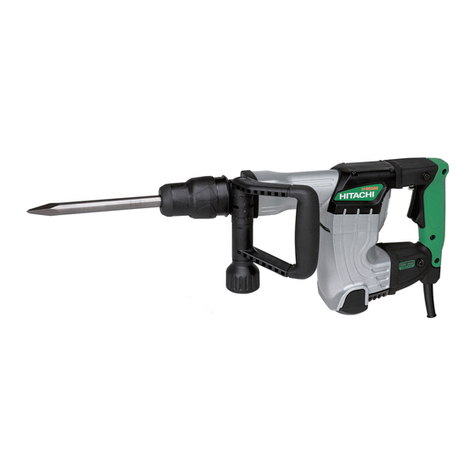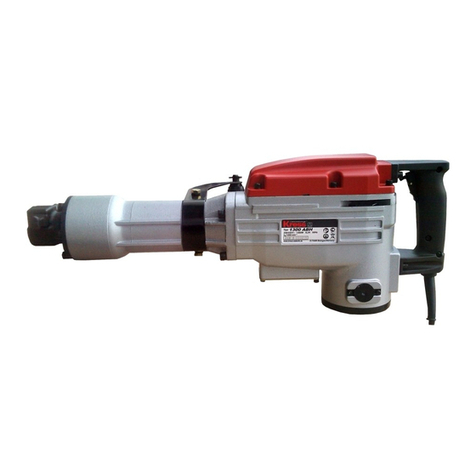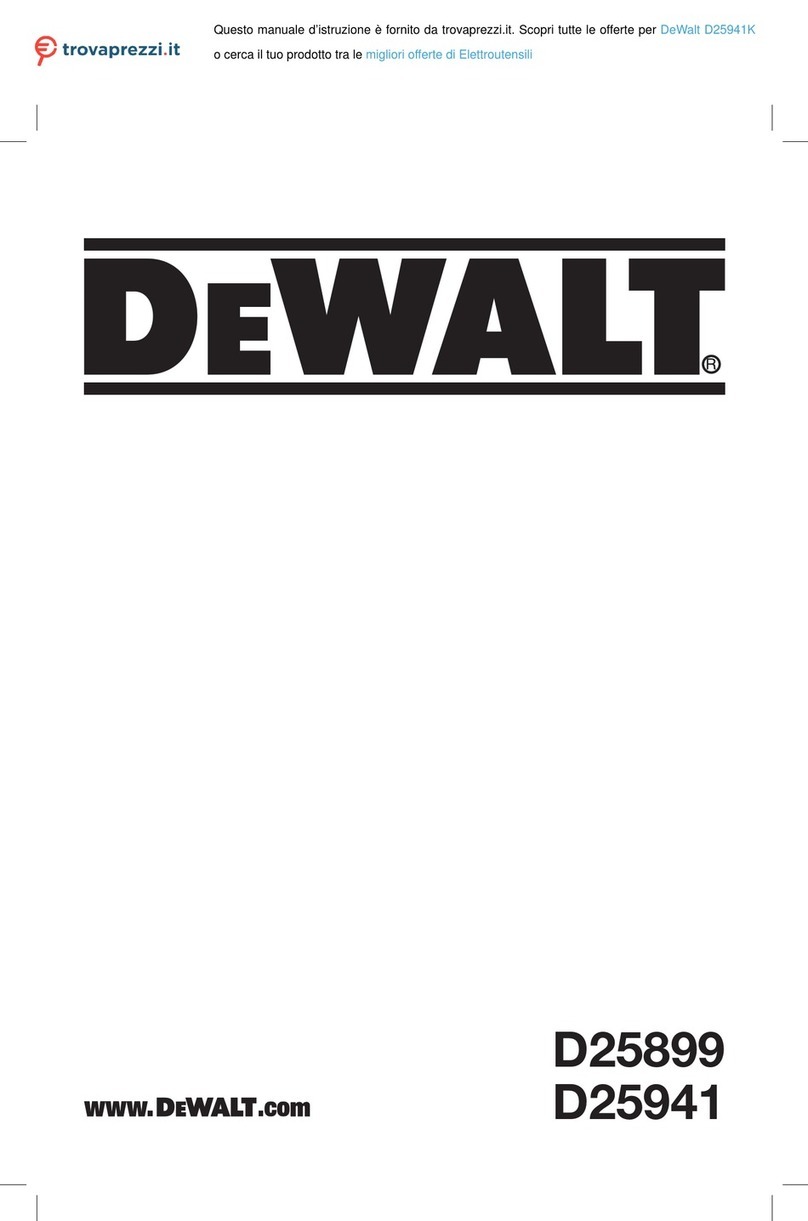Sioux Tools 5272A Specifications

Model 5272A, 5273A & 5274A
Air Hammer
Form
#
Z492A
Date 2-02/A
(D
Operator Instructions
Includes - Foreseen Use, Work Stations, Putting Into Service,
Operating, Dismantling, Assembly and Safety Rules.
Important
Read these instructions carefully before installing, operating,
servicing or repairing this tool. Keep these instructions in a safe
accessible place.
Manufacturer/Supplier 8PM
See
Specifications
Sioux Tools, Inc.
117 Levi Drive
Murphy, NC 28906
U.S.A.
Tel No. 828-835-9765 Fax No. 828-835-9685
Product Net Weight
5272A 5273A 5274A
3.00 3.75 4.40 Ibs
1.40 1.70 2.00 kg
Recommended Use Of
Balancer Or Support
NO
Product Type
0.401 " Shank
Air Hammer
CE
Model No/Nos
5272A -
Short
5273A -
Medium
5274A -
Long
Serial No.
Recommended Max.
Hose Length
30 Ft 10 M
Recommended Hose Bore
Size - Minimum
3/8 ins 10 mm
Air Pressure Noise Level: Sound Pressure Level 100.0 dB(A)
Sound Power Level 110.0 dB(A)
Recommended Working 6.2
Maximum 6.2 bar 90
bar 90 PSI
PSI Test Method: Tested in accordance with Pneurop
test code PN8NTC1 and ISC Standard 3744
SAFETY MESSAGES
A
WARNING
Personal Safety Equipment
e
Always Read Instructions
Uso - Safety Glasses YES Before Using Power Tools
Use- SafetyGloves
Y S
(;)
Always Wear Safety
Goggles
Use- SafetyBoots •Wear Hearing Protection
Use- BreathingMasks
Y S
Use- EarProtectors
Y S
I &
Avoid Prolonged Exposure
To Vibration
Safety rules when using a 5272A,
5273A or 5274A Air Hammer
- Always wear safety goggles as use of tool may cause
flying objects.
- Prolonged exposure to vibration may cause injury.
- Read all instructions before using this tool. All
operators must be fully trained in its use and aware of
these safety rules.
- Do not exceed the maximum working air pressure.
- Use personal protection equipment as recommended.
- Some dust created by power sanding, sawing, grinding,
drilling, and other construction activities contains
chemicals known to cause cancer, birth defectsand other
reproductive harm.
- Use only compressed air at the recommended
conditions.
- If the tool appears to malfunction,
remove from use immediately and
arrange for service and repair. If it is
not practical to remove tool from
service, then shut off the air supply
to the tool and write or have written a
warning note and attach it to the tool.
- If tool is to be used with a balancer or
other suspension device, ensure that
the tool is firmly attached to the
suspension/support device.
- When operating the tool, always keep
the body and particularly the hands
away from the working attachment
Vibration Level 13.9 Meters / Sec2
Test Method: Tested in accordance with ISO
standards 8662 Part 1
fixed to the tool.
- The tool is not electrically insulated. Never use the tool
if there is any chance of coming into contact with live
electricity.
- Always when using the tool, adopt a firm footing and/or
position and grip the tool sufficiently only to overcome
any reaction forces that may result from the tool doing
work. Do not overgrip.
- Use only correct spare parts for maintenance and
repair. Do not improvise or make temporary repairs.
Major servicing and repairs should only be carried out
by persons trained to do so.
- Do not lock, tape, wire, etc. the 'On/Off' valve in 'On'
position. The trigger/lever, etc. must always be free to
return to the 'Off' position when released.
Take Air From Top
Drain Dally
All Pipe And Fittings
Should 8e
1/2
Or Larger---.
Compressor
with Sufficient Capacity
To Maintain Recommended
Working Pressure At
tlet
Low Spot To
Trap Water
Easy To Reach And Air Tool
Operata Shut Off Valve
,¥"
Air Regulator Set At
Recommended Working
A
Air Pressure
( Receiver Tank \
o Galions Or MoreM!.,)::::=C
/I \\
Drain Daily
" W '"
Filter Lubricator
Recommended Air Supply System
Page No 1
Figure 1

- Always shut off the air supply to the tool and press the
'On/Off' valve to exhaust the air from the feed hose
before fitting, removing or adjusting the working
attachment fitted to the tool.
- Before using the tool, make sure that a shut off device
has been fitted to the air supply line and the position is
known and easily accessible so that the air supply to
the tool can be shut off in an emergency.
- Check hose and fittings regularly for wear.
- Take care against entanglement of the moving parts of
the tool with clothing, hair, ties, cleaning rags, rings,
jewelry, watches, bracelets, etc. This could cause the
body or parts of the body to be drawn towards and in
contact with the moving parts of the tool and could be
very dangerous.
- It is expected that users will adopt safe working
practices and observe all local, regional and country
legal requirements when installing, using or
maintaining the tool.
- Take care that the exhaust air does not point towards
any other person or material or substance that could
be contaminated by oil droplets. When first lubricating
a tool or if the tool exhaust has a high oil content, do
not allow the exhaust air to come near very hot
surfaces or flames.
- Never lay the tool down until the working attachment
has stopped moving.
- When the tool is not in use, shut off the air supply and
press the trigger/lever to drain the supply line. If the
tool is not to be used for a period of time, first lubricate,
disconnect from air supply and store in a dry average
room temperature environment.
- If the tool is passed from one user to a new or
inexperienced user, make sure these instructions are
passed with the tool.
- Do not remove any manufacturer fitted safety devices
where fitted, i.e., wheel guards, safety trigger, speed
governors, etc.
- Wherever possible, secure workpiece with clamps, a
vise, etc. to make it rigid so it does not move during the
work operation. Keep good balance at all times. Do not
stretch or overreach.
- Try to match the tool to the work operation. Do not use
a tool that is too light or heavy for the work operation. If
in doubt, seek advice.
-In general terms, this tool is not suitable for
underwater use or use in explosive environments -
seek advice from manufacturer.
- Try to make sure that the work area is clear to enable
the work task to be performed safely. If practical and
possible, try to clear unnecessary obstructions before
starting work.
- Always use air hose and couplings with minimum
working pressure ratings at least 1 1/2 times the
maximum working pressure rating of the tool.
Foreseen Use Of The Tool - 5272A,
5273A 5274A
This tool is designed for the purpose of chipping, riveting and scaling
of metals and stone. In general terms, a reciprocating free piston in
the cylinder of the tool imparts a blow to the chisel or working attach-
ment. A list of suitable equipment to use with this tool can be pro-
vided by the manufacturer. Do not use the tool for any other purpose
than that for which it was designed without first consulting the manu-
facturer or the manufacturer's authorized representative.
Do not modify the tool even for its use as a chipper, etc. or for any
other purpose without first consulting the manufacturer or his
authorized representative.
Page N02
Work Stations
The tool should only be used as a handheld, hand operated tool. II is
always recommended that the tool is used when standing on a solid
floor. It can be used in other positions, but before any such use, the
operator must be in a secure position having a firm grip and footing
and be aware of the extra safety precautions that must be observed
when using the air hammer
Putting Into Service
AirSupp y
Use a clean lubricated air supply that will give a measured air
pressure at the tool of 90 p.s.i./6.2 bar when the tool is running
with the trigger/lever fully depressed. Use recommended hose size
and length. It is recommended that the tool is connected to the air
supply as shown in figure 1. Do not connect the tool to the air line
system without incorporating an easy to reach and operate air shut
off valve. The air supply should be lubricated. It is strongly
recommended that an air filter, regulator, lubricator (FRL) is used
as shown in Figure 1 as this will supply clean, lubricated air at the
correct pressure to the tool. Details of such equipment can be
obtained from your supplier. If such equipment is not used, then
the tool should be lubricated by shutting off the air supply to the
tool, depressurizing the line by pressing the trigger/lever on the
tool. Disconnect the air line and pour into the hose adaptor a
teaspoonful (5ml) of a suitable pneumatic motor lubricating oil
preferably incorporating a rust inhibitor. Reconnect tool to air
supply and run tool slowly for a few seconds to allow air to
circulate the oil. If tool is used frequently, lubricate on daily basis
and if tool starts to slow or lose power.
It is recommended that the air pressure at the tool while the tool is
running is 90 psi/6.2 bar.
Operating
With the air supply disconnected, select the appropriate chisel
attachment to perform the work task. The Quick Change Chuck (23)
is designed to accept only 0.401" (10.2 mm) diameter round shank
chisels. They can be quickly attached as follows. Screw the Quick
Change Chuck (23) on the threaded end (tapered) of the cylinder
(21). Using a hex wrench, tighten the three hex screws in the base of
the chuck against the cylinder to prevent the turning of the chuck
due to vibration. Then, to install a chisel, pull the textured ring on the
chuck back towards the cylinder, insert chisel until bit collar passes
the four steel balls. Release textured ring and make sure the chisel
is locked in place.
To use the spring retainer, screw the spring clockwise on the threaded
barrel. Insert the chisel through the spring frorn the drive end. The
small end of the spring rnust face the working end of the chisel. Move
it to one side, allowing it to grip the outer shoulder flange of the chisel
bit.
Never fit or remove a chisel with the air supply connected as
accidental starting could cause the chisel to fly out of the tool
causing serious injury.
The trigger (14) is the on/off valve for the tool. The power regulator
(6) on the bottom of the handle regulates the flow of cornpressed air
fed to the piston, which regulates the blow rate and the power of
each blow.
An air strainer is built into the air inlet bushing (3). This should be
checked periodically for blockage, particularly if the tool appears to
lose power. It can be cleaned by removing air inlet bushing (3).

Dismantling Assembly Instructions Remove roll pin (2) to allow air regulator (6) to be pulled out
completely with a-rings (5) and cap (4). Tap out roll pin (2) and pull
Disconnect tool from air supply. out the trigger assembly. Grip valve stem (8) and pull oH trigger
Pull textured ring on the back
01
Quick Change Chuck (23) toward button (14). This will release the valve parts; spring (13). a-ring (10).
cylinder (21) and take out chisel as fitted. Unscrew the Quick Change valve bushing (11). a-ring (9) and a-ring (7).
Chuck (23). Grip housing (1) in a vise fitted with soft jaws and un-
screw cylinder (21). If this proves to be diHicult to unscrew. use an
Reassembly
extension bar on the spanner and/or provide local heating to the
threaded area to soften and break the grip of the thread locking seal- Clean all parts and examine for wear. Replace any components with
ant. Then remove valve block assembly (15) from cylinder (21
).11
the parts obtained from the manufacturer or authorized distributor. Coat
valve block assembly (15) is not attached to the end
01
the cylinder all parts with a suitable pneumatic lubricating oil and then reassemble
(21). remove tool from vise and tap the front end of housing (1) to in the reverse order. Fit chisel or attachment as required.
dislodge it. Return housing (1) to vise and unscrew inlet bushing (3).
Operation Specification
5272A 5273A 5274A
Average Air Consumption 4.0 clm (28 scfm) 4.0 cfm (28 scfm) 4.0 cfm (28 scfm)
Blows Per Minute 4.800 3.000 2.200
Piston Stroke 1-5/8 (41 mm) 2-5/8 (66 mm) 3-7/8 (98 mm)
Air Inlet Thread 1/4-18NPT 1/4-18NPT 1/4-18NPT
LenQth (without Q.C. Chuck) 7' (175 mm) 8-1/16 (205 mm) 10-1/4' (260 mm)
at 90 PSIG 16.2 bar
NOTES
Declaration of Conformity
Sioux Tools Inc.
117 Levi Drive, Murphy, NC 28906, U.S.A.
declare under our sole responsibility that the product
E
Model 5272A, 5273A 5274A Air hammer, Serial Number
to which this declaration relates is in conformity with the following standard(s) or other normative document(s)
EN792 (Draft), EN292 Parts 1 2, ISO 8662 Part 1, Pneurop PN8NTC1
following the provisions of 89/3921EEC as amended
by
91 368IEEC
93 44 EEC Directives
--------------- )---------------
Name
and signature or equivalent marking of authorized person
Printed in Taiwan
Page No 3

ti'OU)t
Modele 5272A, 5273A
5274A
'i )'
Marteau Pneumatique
Instructions de fonctionnement
Comprend : Utilisation prevue, stations de travail, mise en
service, fonctionnement, demontage, montage et regles de
securite.
Important
Lisez attentivement ces instructions avant d'installer, de faire
fonctionner, d'entretenir ou de reparer cet outil. Gardez ces
instructions dans un endroit sur et facilement accessible.
FabricantiFournisseur Coups/min
Voir
specifications
Sioux Tools, Inc.
117 Levi Drive
Murphy, NC 28906
U.S.A.
Tel No. 828-835-9765
Type de produit
Marteau pneumatique
pour tige de 10,2 mm
(0,401 po)
E
Fax No. 828-835-9685
Poids net du produit
5272A 5273A 5274A
1,40 1,70 2,00 kg
Emploi conseille d'un
dispositif d'equilibraqe ou
d'un support. NON
Nurnero du modele
5272A - court
5273A - moyen
5274A -Ion
Alesaqe
de tuyau recomrnande
Taille minimum
10mm
Nurnero de serie
Longueur maximum de
tuyau recornrnandee
10
m
Pression d'air
De fonctionnement
recornrnandee 6,2 bar
6,2 bar
Maximum
Niveau sonore:
Niveau de pression sonore 100,0 dB(A)
Niveau de puissance sonore 110,0 dB(A)
Methode de test: Teste selon Ie code de test
Pneurop PN8NTC1 et la norme ISO 3744.
13,9 rn/s-
Messages de securite
Equipement de
securite personnelle
Lunettes de secunts
OUI
Gants de securite
OUI
Bottes de securite
Masques
OUI
Protecteurs auriculaires
QUI
AMISE EN GARDE
O
Lisez toujours les instructions
. ' avant d'employer des outils
electriques
Portez toujours des lunettes de
W
securite
•Portez toujours des dispositifs
de protection antibruit
L':I.
Evitez I'exposition prolonqse
l!fil
aux vibrations
Regles de securlte pour I'emploi d'un
marteau pneumatique 5272A, 5273A
ou 5274A
• IIfaut toujours porter des lunettes de securite et un masque
respiratoire.
• Une exposition prolonqss aux vibrations peut causer des
blessures.
• Lisez les instructions avant d'employer cet outil. Tous Ie
operatsurs doivent connaTtre parfaitement son utilisation
et connaTtre ces regles de securlte,
• Ne depassez pas la pression d'air de fonctionnement
maximum.
• Employez l'equipement de protection personnelle
recornrnande. .
• Certaines pousslerss engendrees par Ie poncaqa, Ie
sciage, Ie meulage, Ie percaqe pneumatique et d'autres
activites de construction contiennent
des produits chimiques qui sont conn us
comme provoquant Ie cancer, des
anomalies conqenitales et d'autres
troubles reproductifs.
• Employez seulement de I'air cornprlms
dans les conditions recornmandess.
• Si routil semble mal fonctionner, arretez
lmrnediaternent son emploi et faites-Ie
reparer, S'il est difficile d'enlever routil de
son aire de service, arrstez l'arrlvee d'air et
fixez une note d'avertissement manuscrite
al'outil.
• Si l'outil doit etre employe avec un
dlsposititd'equllibraqe ou de suspension,
Methode de test: teste selon les normes ISO
8662, section 1
Niveau de vibrations
assurez-vous que I'outil est bien fixe a ce systems de
suspension ou de support,
• Quand vous employez l'outil, tenez toujours Ie corps et les
mains a l'scart des accessoires de travail fixes a I'outil.
• Cet outil n'est pas isole electriquement. N'employez jamais
cet outil si vous risquez d'entrer en contact avec de
l'electrlcite,
• Quand vous employez cet outil, prenez une position ferme
et tenez bien I'outil pour compenser toutes forces de
reaction qui pourraient etre causees par Ie fonctionnement
de I'outil. Ne serrez pas trop fort dans les mains,
• Employez seulement des pieces de rechange correctes
pour I'entretien et les reparations. N'improvisez pas de
reparations temporaires. L'entretien et les reparations ne
doivent etre effectuees que par du personnel qualifie,
• Ne bloquez pas les valves "On/Off" en position dans la
position "On" (en service). Le levier de commande doit
toujours etre libre de retourner dans la position "Off' (hors
Outil
Robinet d'arret d'acces pneumatique
et d'usage faciles
/ Re ulateur d'air regie
a la pression de
fonctionnement recomrnandee
Tous les tuyaux et raccords
doivent avoir un dlarnetre
d'au moins 1,27 em
(1/2 )
Prise d'air au sommet
Compresseur de
capacite
sufficante pour maintenir
la pression de fonctionnement
recomrnandee
a
chaque
sortie d'accessoire
Point bas pour
recuperation de I'eau
Filtre Lubrificateur Purger
quotidiennement
Systerne d'alimentation d'air recornrnande Figure 1
..
----
Page No4

service) quand on Ie relache.
• Arretez toujours I'arrivee d'air
a
I'outil et appuyez sur la
valve "On/Off' pour purger I'air du tuyau d'alimentation
avant de placer, enlaver ou regler les accessoires de
travail sur I'outil.
• Avant d'utiliser cet outil, assurez-vous qu'un robinet
d'arret a ete place sur la conduite d'alimentation et que
vous connaissez sa position etque vous pouvezy acceder
facilement pour arrster I'alimentation en cas d'urgence.
• Verifiez I'usure du tuyau et des raccords regulierement.
• Faites attention de ne pas accrocher les vetements, les
cheveux, les ceintures, les torchons de nettoyage, les
bagues, la bijouterie, les montres, les bracelets, etc.,dans
une piece en mouvement. Ceci risquerait de rapprocher Ie
corps ou une partie du corps contre ces pieces en
mouvement de I'outil et peut etre extremement
dangereux.
• IIest entendu que les utilisateursadopteront des pratiques
de travail sans danger et observeront tous les reglements
locaux, regionaux ou nationaux lors de I'installation, de
I'emploi ou de I'entretien de I'outil.
• Faites attention que la sortie d'air ne soit pas dirigee vers
une autre personne ou quelque materielou substance qui
pourrait etre contarnine par des gouttelettes d'huile.
Quand vous lubrifiez un outil pour la premiere fois ou si
I'echappement a un contenu trop eleve en huile, eloignez
I'air d'achappement des surfaces tres chaudes et des
flammes.
• Ne dsposez jamais I'outil avant I'arret total des
accessoires de travail.
• Quand I'outil n'est pas employe, arretez I'alimentation
d'air et appuyez sur Ielevierpour purger I'airde laconduite
d'alimentation. Si vous pensez ne pas I'employerpendant
un certain temps, commencez par Ie lubrifier, puis
deconnectez I'alimentation d'air et rangez-Ie dans une
piece
a
temperature ambiante et non humide.
• Si ,"outil passe
un utilisateur nouveau ou peu
experirnente, soyez sur que ces instructions lui sont
donnees en meme temps que I'outil.
• N'enlevez pas les dispositifs de securite dont Ie fabricant
a equipe I'outil, comme les protege-roues, gachette de
secunte, regulateurs de vitesse, etc.
• Autant que possible, fixez la piece sur laqualle vous
travaillez dans un collier de serrage, un stau, etc. pour
I'immobiliser durant Ie travail. Soyez toujours bien en
equilibre. IIne faut jamais vous pencher ni etendre Iebras
excessivement.
• Essayez de faire correspondre I'outil avec Ie travail.
N'employez pas un outil qui est trop leger ou trop lourd
pour Ie travail, en cas de doute, demandez conseil.
• De maniers generale, cet outil ne convient pas pour Ie
travail sous I'eau ou
proximite d'explosifs - demandez
I'avis du fabricant.
• L'aire de travail devrait etre libre d'encombrements pour
permettre un travail sans danger. Si possible et pratique,
essayez d'enlever toutes obstructions inutiles avant de
commencer
travailler.
• Employez toujours un tuyau d'air et des raccords dont les
conditions nominales de fonctionnement sont au moins
une fois et demi plus grandes que la pression de
fonctionnement maximum de I'outil.
Utilisation prevue de I outil- 5272A,
5273A, 5274A
Cet outil est destine
buriner,
riveter,
derouiller et
oetartrer les
meraux et lapierre. En termes generaux, un piston libre altematif
dans Ie cylindre de I'outil imp rime uncoup au burin ou
I'accessoire
de travail. Vous pouvez obtenir une liste des accessoires utilisables
avec cet outil aupres du fabricant ou de son representant autorise.
N'employez pas l'outll dans un but different de celui pour lequel il a
ete coocu sans consulter au prealable Ie fabricant ou son representant
autonse,
Ne modifiez par I'outil meme pour I'employer comme burin, etc., ou
dans quelque autre but que ce soit, sans consulter au prealable Ie
fabricant ou son representant autorlss.
Stations de travail
Cet outil ne doit etre employe que manuellement. On recommande
de toujours employer I'outil en position debout et sur un sol ferme.
On paut I'employer dans d'autres positions mais
v nt
un tel emploi,
rooerateur doit etre en position stable, avoir I'outil bien en main et
connaitre les regles de secunts qu'iI faut suivre quand on emploie
un marteau pneumatique.
Mise en service
limentation
dair
Employez une alimentation d'air propre et lubrifiee qui apporte une
pression d'air rnesuree
I'outil de 6,2 bar quand I'outil est en marche
et que la maneUe de commande est cornoteternent entoncee,
Employez un tuyau de la longueur et de la taille recommandees.u est
conseille de connecter I'outil
I'alimentation d'air selon les
indications de la figure 1. Ne connectez pas I'outil aux conduites d'air
sans incorporer un robinet d'arret d'acces et d'usage facile.
L'alimentation d'air doit lllre lubriliee. II est fortement conseine
d'employer un liltre
air, un regulateur et un lubrificateur (FRL)
comme indique
la figure 1, car cela permet une alimentation d'air
propre et lubrifie
la bonne pression
I'outil. Vous pouvez obtenir les
details de cet equipement au pres de votre revendeur. Si vous
decidez de ne pas employer cet equipement, il faut lubrifier I'outil en
arretant I'alimentation d'air, puis en purgeant la pression la conduite
en appuyant sur Ie levier de commande. Deconnectez la conduite
d'air et versez une cuillere (5 ml) d'huile pour moteur pneumatique
(avec antirouille de preference) dans I'adaptateur de tuyau.
Reconnectez I'outil
I'alimentation d'air et mettez I'outil en marche
pendant quelques secondes pour que la circulation d'air permette la
distribution de I'huile. Sl l'outll est employe frequemment ou si I'outi
ralentit ou perd de sa puissance, lubrttiez-Ie taus les jours.
On recommande une pression d'air
I'outil de 6,2 bar/90 psi quand
I'oulil est en marche.
Fonctionnement
Deconnectez I'alimentation d'air et choisissez I'accessoire ou burin
approprie pour Ie travail. Le mandrin de changement rapide (23) est
concu pour n'accepter que des burins avec tige circulaire de 10,2
mm de diarnetre. On peut les fixer rapidement de la rnanlsre suivante.
Vissez Ie mandrin de changement rapide (23) sur Ie bout filete
(conique) du cylindre (21). Avec une cle hexagonale, serrez les trois
vis hexagonales
la base du mandrin contre Ie cylindre pour evtter
que les vibrations ne lassent tourner Ie mandrin. Puis, pour installer
un burin, tirez la bague tenures du mandrin vers Ie cylindre, msersz
Ie burin jusqu'a ce que la bague du burin passe
au-cera
des quatra
billes d'acier. RelAchez la bague texturee et assurez-vous que Ie
burin est bloque.
Pour employer la bague de fixation
ressort, vissez Ie ressort dans
Ie sens des aiguilles d'une montre sur Ie cylindre filete. lnssrez Ie
burin dans Ie ressort du cOte de I'entrainement. Le petit bout du ressort
doit faire face
I'extremite de fonctionnement du burin. Poussez-Ie
de cote, pour lui permettre de serrer Ie rebord externe du burin.
Ne placez jamais un burin quand I'outit est connects
l'arnvee d'air
car un dernarraqe accidentel du I'outil pourrait faire sauter Ie burin et
causer des blessures graves.
Le bouton de gAchette (14) est la commande marche - arret de I'outil.
Le regulateur de puissance (6) dans Ie fond de la polqnes ragle Ie
flux d'air cornprlme qui arrive au piston, qui
son tour regie Ie taux
de coups et la puissance de chaque coup.
Un liltre
air est encastre dans la douille d'entree d'air (3). II laut
regulierement verifier qu'it n'est pas btoque, surtout si I'outil semble
perdre de sa puissance. On peut Ie nettoyer en enlevant la douille
d'entree d'air (3).
Page NoS
This manual suits for next models
2
Table of contents
Languages:
Popular Power Hammer manuals by other brands
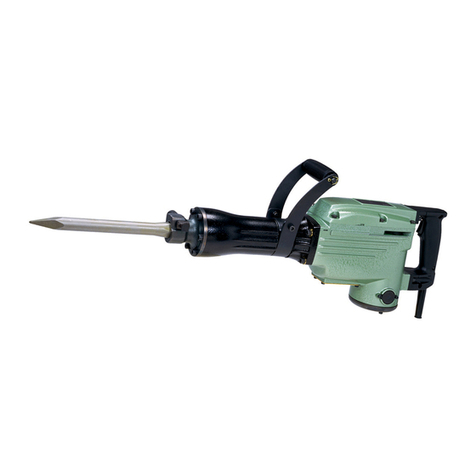
Hitachi
Hitachi H 65SC Instruction manual and safety instructions

Hitachi
Hitachi H 65SB2 Handling instructions
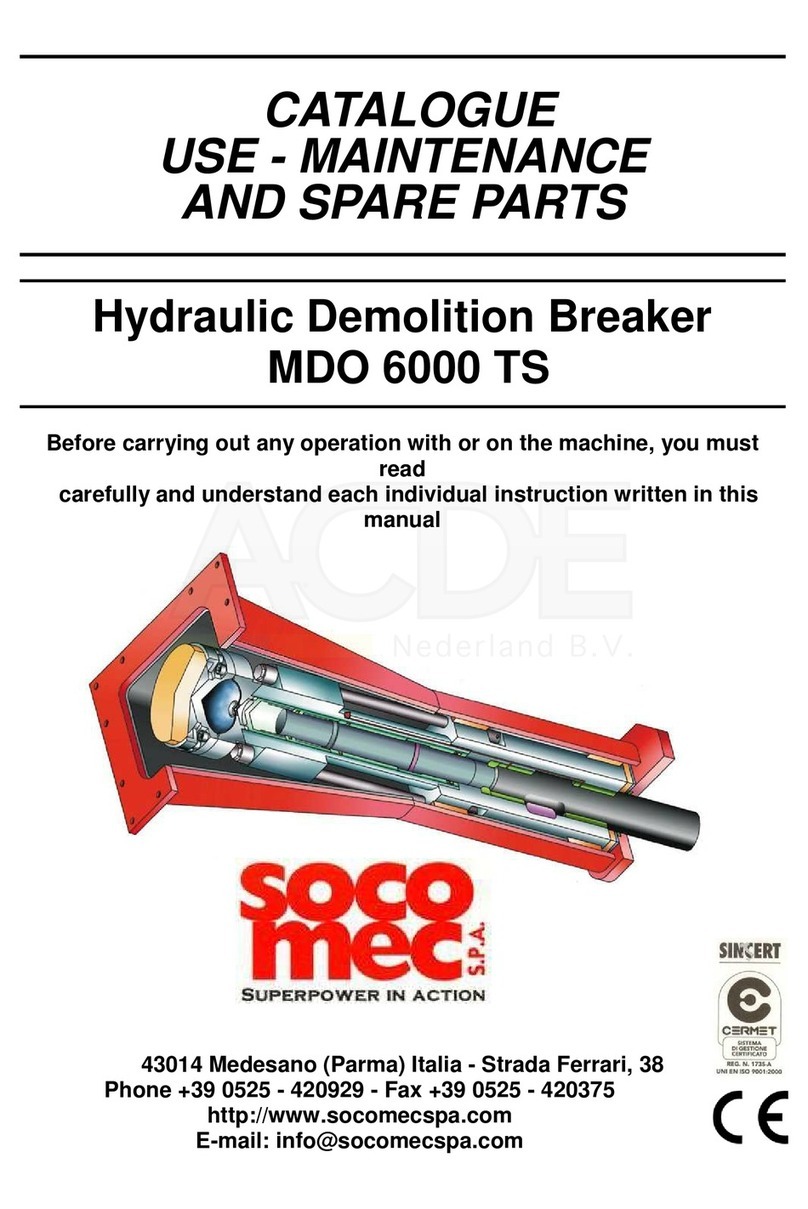
socomec
socomec MDO 6000 TS Use & maintenance
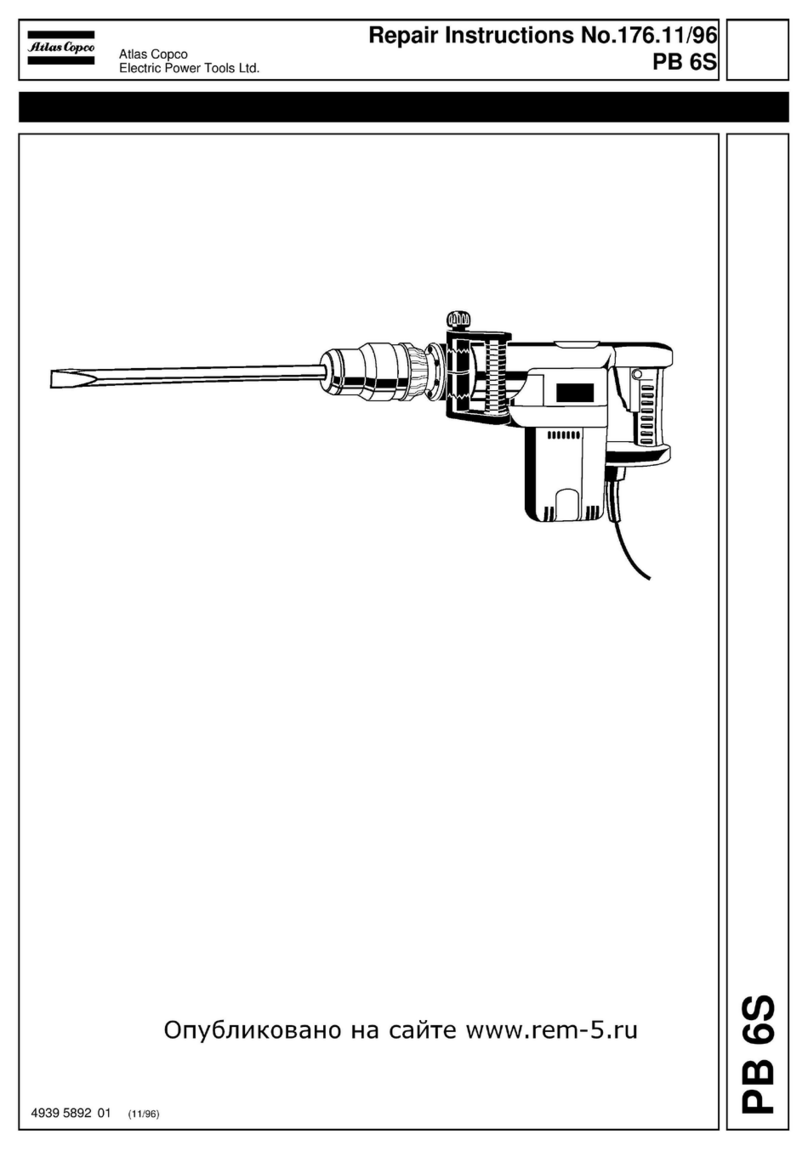
Atlas Copco
Atlas Copco PB 6S Repair instructions
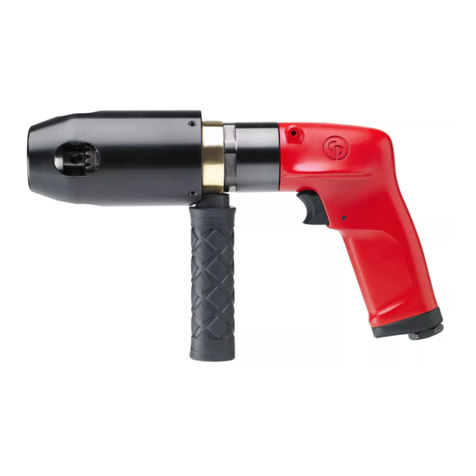
RODCRAFT
RODCRAFT RC5030 Operation manual
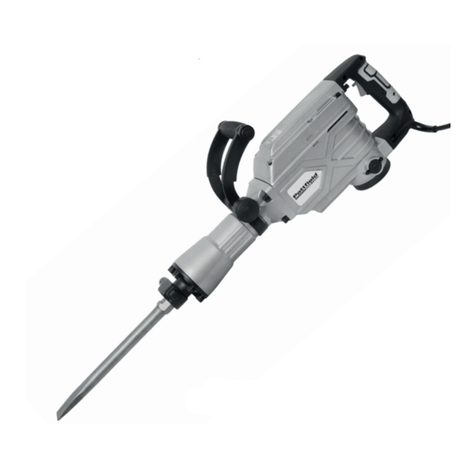
Pattfield Ergo Tools
Pattfield Ergo Tools PA-1700SH Translation of the original instructions
